8.04.2023
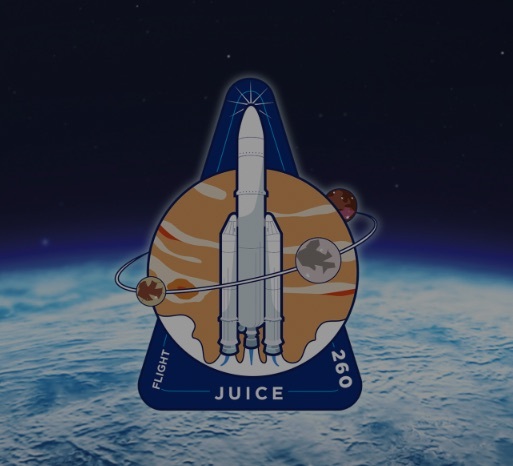
Launch of Europe's 1st-ever Jupiter probe is just a week away
The Jupiter Icy Moons Explorer is scheduled to lift off on April 13.

After its arrival in the final assembly building on April 1, 2023, ESA’s Jupiter Icy Moons Explorer (JUICE) spacecraft was slowly lifted into the air and then carefully lowered onto the top of the Ariane 5 rocket that will launch it into space on April 13. Here we see technicians working atop the rocket, bolting down JUICE launch vehicle adapter to keep it secure during launch. (Image credit: ESA - M. Pédoussaut
The launch of Europe's first-ever Jupiter mission is just a week away.
The European Space Agency's (ESA) Jupiter Icy Moons Explorer probe, or JUICE for short, is scheduled to lift off atop an Ariane 5 rocket from Europe's Spaceport in Kourou, French Guiana at 8:15 a.m. EDT (1215 GMT) on April 13.
You can watch the launch here at Space.com when the time comes, courtesy of ESA.
The liftoff will kick off a long interplanetary journey for JUICE, which will end with the spacecraft's arrival in orbit around Jupiter in 2031.
The 6.6-ton (6 metric tons), solar-powered probe will then conduct a series of flybys of three of Jupiter's four big Galilean moons — Ganymede, Europa and Callisto, all of which are thought to possess oceans of liquid water beneath their icy shells. (JUICE will not study the fourth Galilean moon, the incredibly volcanic Io, in such detail.)
Then, in 2035, JUICE will shift from Jupiter's orbit to that of Ganymede, the largest moon in the solar system. The move will make JUICE the first probe ever to orbit a moon other than that of Earth.
All the while, JUICE will be eyeing Jupiter and the three target moons with its powerful suite of 10 science instruments, studying them in unprecedented detail.
"The mission will characterize these moons as both planetary objects and possible habitats, explore Jupiter's complex environment in depth and study the wider Jupiter system as an archetype for gas giants across the universe," ESA officials wrote in a mission description(opens in new tab).
JUICE's launch will be followed in relatively short order by that of another Jupiter mission — NASA's Europa Clipper, which is scheduled to lift off atop a SpaceX Falcon Heavy rocket in October 2024.
As its name suggests, Europa Clipper will focus on Europa, studying the icy moon in detail during dozens of flybys. (Clipper will orbit Jupiter, as JUICE will initially.)
Many astrobiologists view Europa as one of the solar system's best bets to host alien life, partly because the moon's ocean appears to be in contact with its rocky core, allowing complex chemistry to occur. The buried oceans of Ganymede and Callisto, by contrast, are thought to be sandwiched between layers of ice.
One mission is currently orbiting Jupiter — NASA's Juno, which arrived at the solar system's largest planet in 2016. Juno's mission is expected to wrap up in 2025.
Quelle: SC
+++
ARIANE FLIGHT VA260
Arianespace’s first launch of 2023 will place the JUICE satellite for ESA on a liberation’s orbit, on his way to the Jupiter system. The launcher will be carrying a total payload of approximately 6058 kg. The launch will be performed in Kourou, French Guiana.
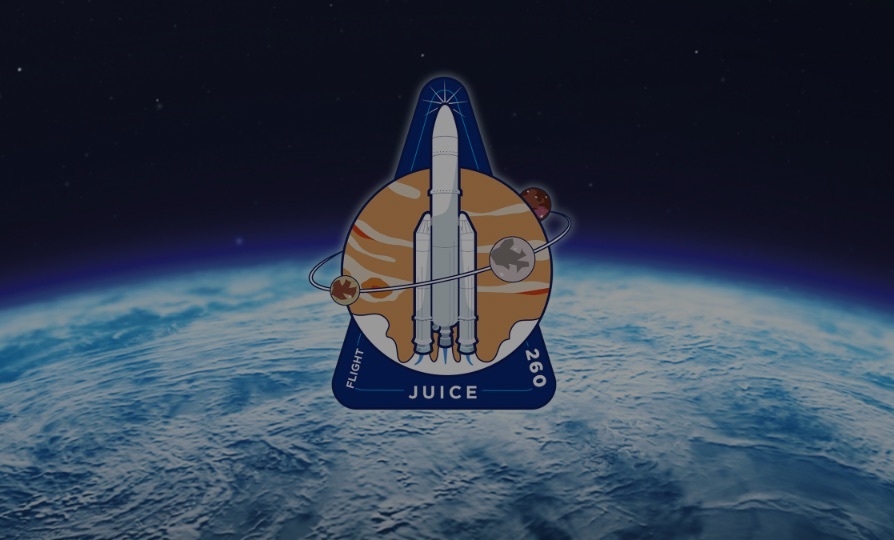
PAYLOAD:
JUICE, ESA’s JUpiter ICy moons Explorer, is the first ‘large-class’ mission of the Cosmic Vision science program. The mission will make detailed observations of the giant gas planet and its three large ocean-bearing moons – Ganymede, Callisto and Europa – with a suite of remote sensing, geophysical and in situ instruments.
The mission will characterize these moons as both planetary objects and possible habitats, explore Jupiter’s complex environment in depth, and study the wider Jupiter system as an archetype for gas giants across the Universe.
After an 8-years cruise toward Jupiter, which includes gravitational assists from Earth and Venus, the spacecraft will enter in orbit around the giant planet in 2031.
JUICE will carry the most powerful scientific payload ever flown to the outer Solar System. It consists of 10 state-of-the-art instruments plus one science experiment that uses the spacecraft telecommunication system with ground-based radio telescopes.
→ Flight VA260 will be the first European mission to Jupiter and its icy moons and 30th scientific mission operated by Arianespace.
→ JUICE will be the 86th spacecraft to be launched by Arianespace for the benefits of ESA.
→ JUICE will be the 140th satellite built by Airbus Defence and Space to be launched by Arianespace
+++
On April 13, 2023 at 09:15 a.m. local time (12:15 p.m. UTC), Arianespace’s next Ariane 5 mission will lift off from Europe’s Spaceport, French Guiana, with the JUICE space probe. The mission’s duration will be a little less than 28 minutes.
For this mission, the Ariane 5 launcher will require over 6 metric tons weight performance, and will aim an Earth escape trajectory. After the separation at an altitude of 1,538 km, JUICE spacecraft will ultimately reach an infinite velocity of up to 2.5 kilometers per second once out of the Earth gravitational field.
The spacecraft, manufactured by Airbus Defence and Space for the European Space Agency (ESA), will be Europe’s first mission to Jupiter. It will spend at least three years making detailed observations of its icy moons: Europa, Ganymede and Callisto. JUICE will study the moons as potential habitats for life, addressing two key questions: what are the conditions for planet formation and the emergence of life, and how does the Solar System work?
JUICE will carry the most powerful scientific payload ever flown to the outer Solar System. It consists of 10 state-of-the-art instruments plus one science experiment that uses the spacecraft telecommunication system with ground-based radio telescopes. After an 8-year cruise toward Jupiter, which includes gravitational assists from Earth and Venus, the spacecraft will enter orbit around the giant planet in 2031. The space probe will make detailed observations of the giant gas planet and its three large ocean-bearing moons: Europa, Ganymede and Callisto. JUICE will characterize these moons as both planetary objects and possible habitats, explore Jupiter’s complex environment in depth, and study the wider Jupiter system as an archetype for gas giants across the Universe.
JUICE, is the first ‘large-class’ mission of the Cosmic Vision science program. This current planning cycle for ESA’s space science missions includes a series of three exoplanets missions that will keep Europe at the forefront of this growing field, each tackling a unique aspect of exoplanet science.
Since its creation, Arianespace has played a major role in supporting scientific efforts to study our Universe. By doing so, the European launch service provider has already launched into orbit 30 state-of-the-art spacecraft that have helped unlock Space’s mysteries, including emblematic missions such as: BepiColombo, Europe's first mission to Mercury which is the least explored planet in the inner Solar System; Herschel, that studied the formation and evolution of stars and galaxies; Planck, Europe's first mission to study the cosmic microwave background, the relic radiation from the Big Bang; Gaia, a global space astrometry mission building the largest, most precise, three-dimensional map of our Galaxy by surveying nearly two billion objects; Smart-1, ESA’s first Moon mission and ESA’s first mission to use ion propulsion for interplanetary navigation; Rosetta that rendezvoused with Comet 67P/Churyumov-Gerasimenko and studied the nucleus of the comet and its environment; and the James Webb Space Telescope, the state-of-the art space telescope exploring the origins of the Universe.
Quelle: Arianespace
----
Update: 10.04.2023
.
Ready for launch: the mission to find alien life on Jupiter’s icy moons
The eight-year, £1.4bn voyage into deep space will explore the frozen oceans of Ganymede, Europa and Callisto
In a few days, a £1.4bn probe will be blasted into space on an eight-year mission to find signs of life on other worlds in our solar system. The spacecraft will not head to local destinations such as the planet Mars, however. Instead, it will fly into deep space and survey the icy moons of distant Jupiter. In doing so, it will open up a new chapter in the hunt for extraterrestrial life.
The Jupiter Icy Moons Explorer - or Juice - will exploit an unexpected feature of our solar system. The greatest reserves of water turn out to exist on worlds very far from Earth, in deep space, and in orbit around the giant planets Jupiter and Saturn. Juice is the first mission to be launched specifically to explore these remote worlds.
“We would like to see whether there are places around Jupiter where life could have started. We need to find a place with internal energy and liquid water,” said Olivier Witasse, the mission’s project scientist. “With the icy moons of Jupiter, we have good reasons to believe that there is more water than on Earth.”
The idea that our best hopes of finding alien life lie with explorations of ice-coated moons in deep space would have seemed ridiculous a few decades ago. Venus and Mars offered our best hopes, it was then assumed. But cloud-shrouded robot spacecraft revealed that Venus had a surface temperature of 475C, hot enough to melt lead, while Mars was found to have lost its atmosphere and surface water billions of years ago. Efforts to find surviving underground supplies have so far been unsuccessful.
At the same time, other US probes discovered that three of Jupiter’s main moons – Ganymede, Callisto and Europa – were worlds of ice that covered vast oceans of liquid water, the one prerequisite needed for the existence of life on Earth.
It was also discovered in 2005 that Saturn’s tiny moon, Enceladus, is spraying water and organic material into space from an underground ocean.
“If ever there was a next-best place to look for life, it’s here,” says the US astronomer Neil deGrasse Tyson on the subject of these icy moons.
Getting there is a different matter, however. Journeys to Mars take about eight months. By contrast, Juice – which is scheduled for launch from the European Space Agency (Esa) spaceport in Kourou in French Guiana on Wednesday – will take about eight years to reach Jupiter, a journey that will require a series of flybys of Earth and Venus to keep it up to speed.
Juice will enter orbit around Jupiter in July 2031, by which time it will have been overtaken by another probe, Nasa’s Europa Clipper, which is taking a shorter route, using flybys of Earth and Mars, to arrive in April 2030.
As its name suggests, the US spacecraft will focus on Europa and is scheduled to make 50 close approaches of the moon, sweeping a few hundred miles over its surface to try to spot areas that could support life.
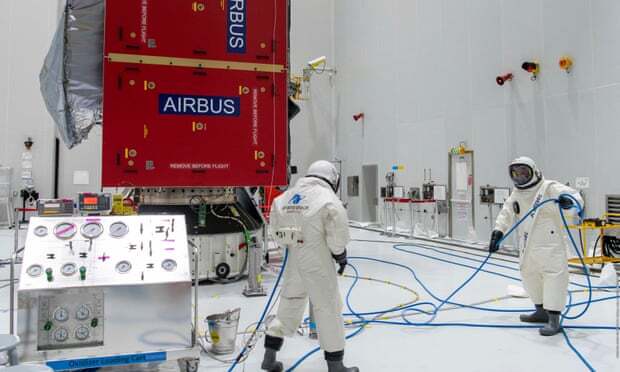
The Jupiter Icy Moons Explorer being fuelled for launch before its eight-year journey to explore Jupiter’s ocean-bearing moons. Photograph: ESA/CNES/Arianespace/PA
“Europa’s ocean is likely in contact with a rocky seafloor,” said Marshall Styczinski, a Europa Clipper scientist. “That means we expect chemical reactions that would create hydrothermal vents, like in Earth’s oceans. Hydrothermal vents support thriving ecosystems on Earth, so they might be doing the same on Europa.”
By contrast, Juice will concentrate on a different target – Ganymede, the largest moon in the solar system. Bigger than the planet Mercury, Ganymede is also the only moon in the solar system with its own magnetic field.
After a series of visits to Callisto and Europa, Juice will enter into a permanent orbit around Ganymede in 2034. It will be the first time a spacecraft has ever held an orbit around a moon other than our own.
And this highlights a crucial difference between the two missions. Ganymede’s orbit is further from Jupiter than Europa’s and so is affected less by the planet’s powerful magnetic field. Juice can survive in orbit round Ganymede, Esa has calculated.
But this is not the case for Europa where the radiation environment will be much more of a threat to the spacecraft’s electronics. Instead, the Clipper will have to sweep over the moon in a series of darting flybys over the length of the three-and-a-half-year mission.
The two missions are being run by separate space agencies, although Nasa and Esa insist there will be close collaboration and have set up a committee to coordinate joint missions that the two spacecraft might attempt.
Results could be revolutionary. If we find that life has evolved twice, separately, in our own solar system, that would indicate it is likely to be widespread throughout the galaxy.
Juice’s blast-off will be watched with bated breath by the scores of European scientists who have collaborated on the project and who will watch as it is carried aloft on an Ariane 5 launcher, the same rocket that placed the James Webb space telescope on a perfect trajectory on Christmas Day 2021. They will be hoping for a repeat performance.
Quelle: The Guardian
----
Update: 11.04.2023
.
ARIANESPACE TO LAUNCH JUICE, EUROPE’S FIRST MISSION TO JUPITER, WITH ARIANE 5
- On April 13, Arianespace will launch the JUpiter ICy moons Explorer (JUICE) space probe for the European Space Agency (ESA) on board its first Ariane 5 mission of the year.
- Flight VA260 will be Europe’s first mission to the Jovian system. Its passenger, JUICE, will spend at least three years making detailed observations of Jupiter’s icy moons Europa, Ganymede and Callisto.
- Built by Airbus Defence and Space, JUICE will enter in orbit around the giant planet in 2031 after an 8-year cruise which includes gravitational assists from Earth and Venus.
On April 13, 2023 at 09:15 a.m. local time (12:15 p.m. UTC), Arianespace’s next Ariane 5 mission will lift off from Europe’s Spaceport, French Guiana, with the JUICE space probe. The mission’s duration will be a little less than 28 minutes.
For this mission, the Ariane 5 launcher will require over 6 metric tons weight performance, and will aim an Earth escape trajectory. After the separation at an altitude of 1,538 km, JUICE spacecraft will ultimately reach an infinite velocity of up to 2.5 kilometers per second once out of the Earth gravitational field.
The spacecraft, manufactured by Airbus Defence and Space for the European Space Agency (ESA), will be Europe’s first mission to Jupiter. It will spend at least three years making detailed observations of its icy moons: Europa, Ganymede and Callisto. JUICE will study the moons as potential habitats for life, addressing two key questions: what are the conditions for planet formation and the emergence of life, and how does the Solar System work?
JUICE will carry the most powerful scientific payload ever flown to the outer Solar System. It consists of 10 state-of-the-art instruments plus one science experiment that uses the spacecraft telecommunication system with ground-based radio telescopes. After an 8-year cruise toward Jupiter, which includes gravitational assists from Earth and Venus, the spacecraft will enter orbit around the giant planet in 2031. The space probe will make detailed observations of the giant gas planet and its three large ocean-bearing moons: Europa, Ganymede and Callisto. JUICE will characterize these moons as both planetary objects and possible habitats, explore Jupiter’s complex environment in depth, and study the wider Jupiter system as an archetype for gas giants across the Universe.
JUICE, is the first ‘large-class’ mission of the Cosmic Vision science program. This current planning cycle for ESA’s space science missions includes a series of three exoplanets missions that will keep Europe at the forefront of this growing field, each tackling a unique aspect of exoplanet science.
Since its creation, Arianespace has played a major role in supporting scientific efforts to study our Universe. By doing so, the European launch service provider has already launched into orbit 30 state-of-the-art spacecraft that have helped unlock Space’s mysteries, including emblematic missions such as: BepiColombo, Europe's first mission to Mercury which is the least explored planet in the inner Solar System; Herschel, that studied the formation and evolution of stars and galaxies; Planck, Europe's first mission to study the cosmic microwave background, the relic radiation from the Big Bang; Gaia, a global space astrometry mission building the largest, most precise, three-dimensional map of our Galaxy by surveying nearly two billion objects; Smart-1, ESA’s first Moon mission and ESA’s first mission to use ion propulsion for interplanetary navigation; Rosetta that rendezvoused with Comet 67P/Churyumov-Gerasimenko and studied the nucleus of the comet and its environment; and the James Webb Space Telescope, the state-of-the art space telescope exploring the origins of the Universe.
- 346th launch for the Arianespace launcher family (309th launch from the Guiana Space Center).
- VA260 will be the 30th scientific mission to be launched by Arianespace.
- 116th launch of Ariane 5 overall.
- JUICE will be the 10th satellite launched by Arianespace on a liberation’s orbit.
Quelle: Arianespace
----
Update: 13.04.2023
.

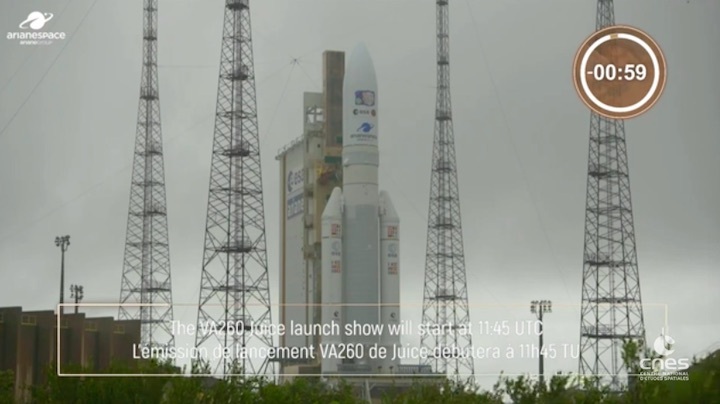







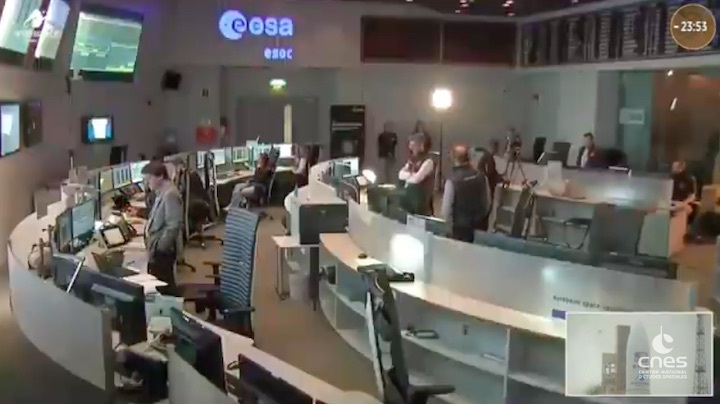






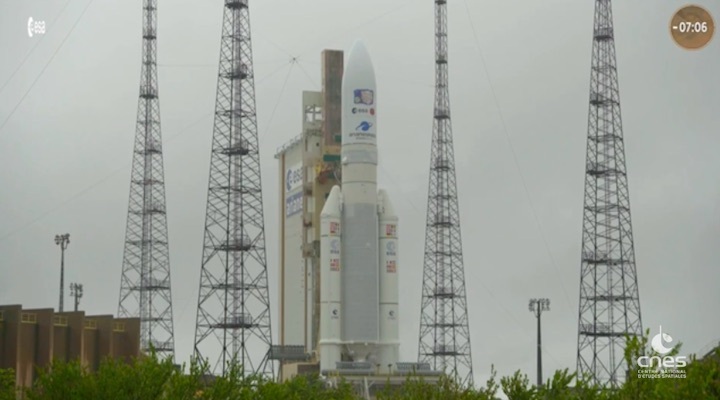
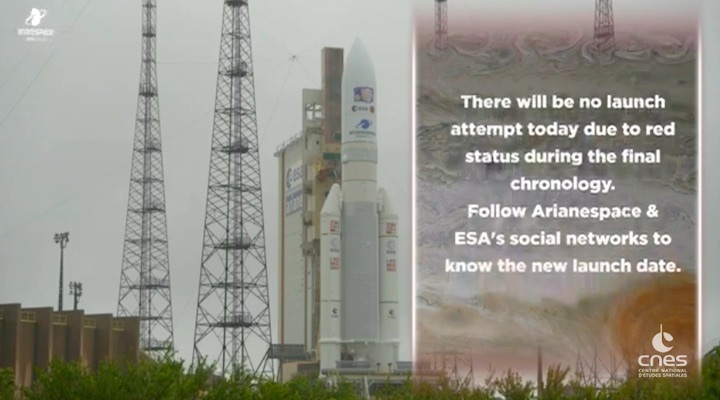
Quelle: ESA ,CNES
----
Update: 14.04.2023
.





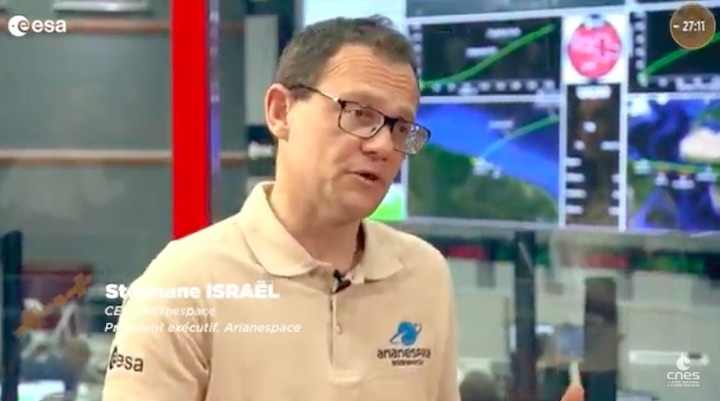






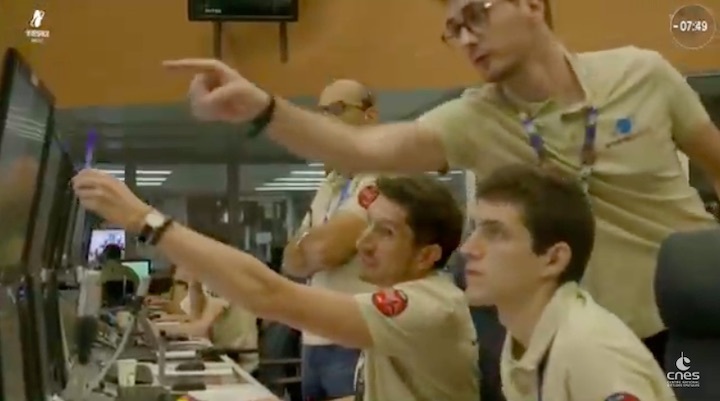


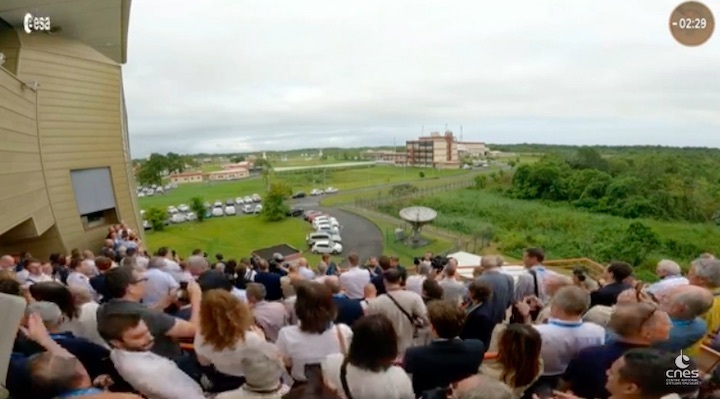
















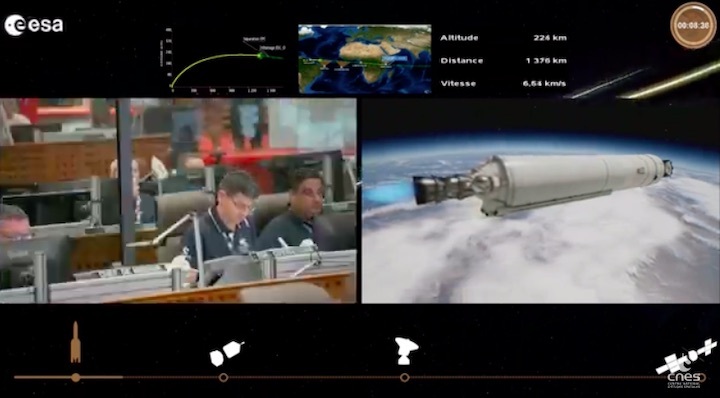
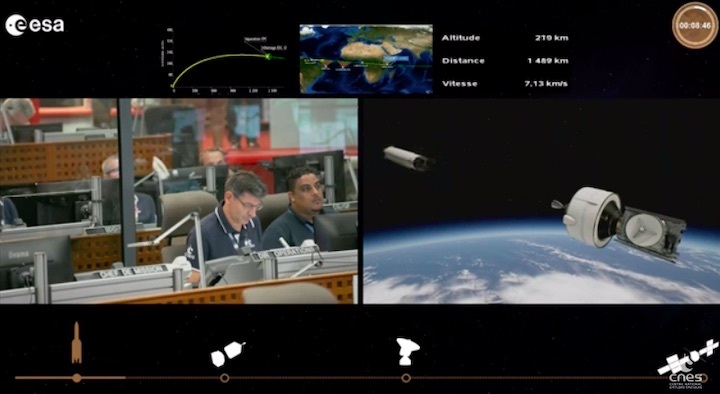





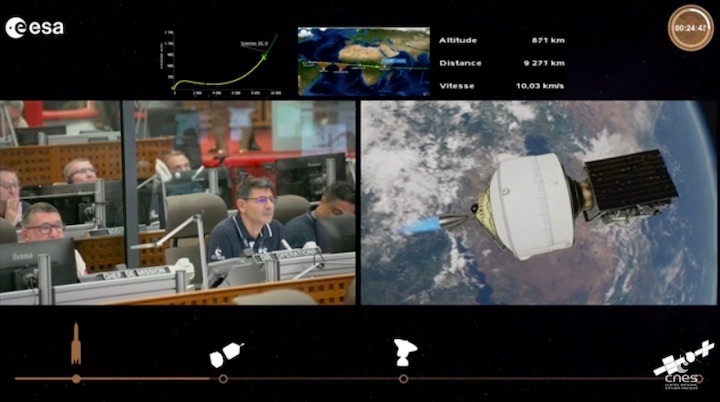


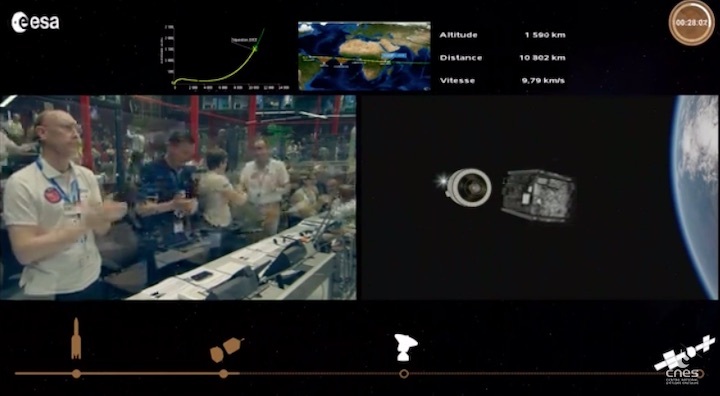


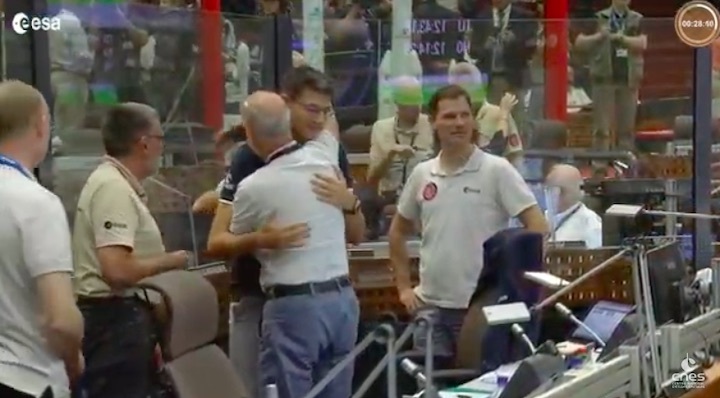

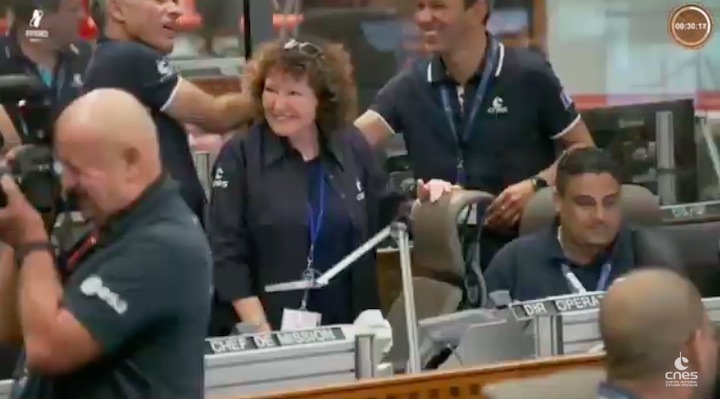
Quelle: ESA ,CNES
